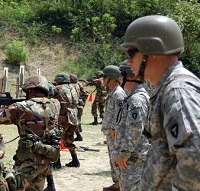
The “standardization of the armed forces” in Latin America according to the needs of the US has been a constant since the beginnings of the Cold War and continues at the present time.
![]()
Source: Latin America in Movement
The discourse on freedom, democracy, diplomatic contacts and friendly relations with Latin America, so characteristic of the Obama administration in their eagerness to reinforce the “soft power” of his foreign policy, finds its real limits in the need for “order” and “stability” (watchwords that were familiar during the implementation of the National Security Doctrine in Latin America). Currently, the US Armed Forces in the Hemisphere are present not only in more than 70 military bases, but also through various multi- and bilateral security agreements: Plan Colombia, the Andean Regional Initiative, the Mérida Initiative, the Initiative for Regional Security of Central America, among others. These pacts include training programmes, capacity building courses, the sale of arms and equipment involving the companies providing these materials and US security agencies such as the DEA and the FBI, as well as the governments, companies and police forces of Latin American countries [1].
The reason for this presence is the “security of the United States”, that implies by definition security and “stability” in territories that could constitute a threat to the United States. In the training manuals of the end of the 1960s, one can clearly read the link between them: “The lack of political stability and socio-economic order in a Latin American country puts in check US national security. Consequently, in matters of training and programs of military aid, the United States should adopt tactics destined to avoid the risks of such instability, through economic development and the imposition of order” [2].
Thus the search for “stability” is part of the discourse that strongly penetrates the region from the beginnings of the Cold War and operates to legitimate interventions over the national sovereignty of States. Currently, in the web page of the Southern Command one can read that one of the objectives of operations such as UNITAS “Southern Seas 2015” is the continuation of “our commitment to the region and is being conducted to enhance regional partnerships and promote hemispheric stability”. It is clear that this common work is carried out with countries and governments that are aligned with the political, economic and security guidelines, that do not alter the precepts of Washington, such as Peru, Chile, Colombia and Panama. The training exercises even reach Brazil: UNITAS trains the armed forces of this country for combat in the field of electronic warfare, in air and submarine warfare, in operations of interdiction, and they also undertake various joint exercises [3].
In general terms, the Southern Command has as its mission to provide friendly nations with training courses, mechanisms for “sharing information”, technological equipment and assistance, as well as assistance in infrastructure (note that this mainly benefits US businesses dedicated to security). In addition, it advises especially in matters of intelligence and in operations to combat drug trafficking and terrorism, always “respecting Human Rights” [4]. It is worth noting how little all of this has been disseminated in public opinion; it is as if this presence of co-opted armed forces were a “natural” component of the sovereignty of the countries of the region even in the context of a reconstruction of memory with respect to counterinsurgency, the forced disappearances, paramilitary operations,, etc., between the decade of the 1950s and the end of the 1980s. Precisely, during the Cold War, the training of Latin American troops in US academies was described as technical training, with no “political-ideological” content. This affirmation was subsequently proven false by what happened in Chile and later in Argentina, when the armed forces occupied the formal political sphere.
Today it is alarming to see the following news item: “Sub-officers of Colombia receive leadership lessons in the United States (…) they will receive instruction in shared leadership, conflict resolution, organizational leadership and behaviour and emotional training, during ten days in the installation of Fort Sam Houston in San Antonio, Texas, from personnel of the US Southern Army” [5]
Some figures illustrate the degree of dependency of the Latin American Armed Forces: the sale of US arms to Latin America and the Caribbean in 2014 amounted to 1,606’861,326 dollars and in 2012 was 2,408’527,664 dollars. The Latin American military who received training in 2013 were 12,157 effectives, while in 2014 they were 14,600. [6].
The “standardization of the armed forces” according to the needs of the US has been a constant since the beginnings of the Cold War and continues at the present time. The internal and external enemy to be combatted may change in name, but is always there to justify the promotion/imposition of Hemispheric Security guaranteeing minimal stability for business (legal, illegal, local, transnational). We therefore never hear the notion of “the end of a cycle” from the empire, but rather “renovation of strategies”.
(Translated for ALAI by Jordan Bishop)
– Silvina M. Romano is a researcher with the Instituto de Estudios de América Latina y el Caribe, UBA, CONICET, Argentina.
Notes:
[1] Borón, A. (2012) América Latina en la geopolítica del imperialismo. Bs As: Luxemburg, pp. 161-188.
[2] Tapia Valdés, J. (1980) El terrorismo de Estado. La doctrina de la seguridad nacional en el Cono Sur. México: Nueva Imagen p. 58
[3] http://www.southcom.mil/newsroom/Pages/US-Marines-train-with-partner-nations-in-Brazil.aspx…
[6] http://www.securityassistance.org/latin-america-and-caribbean
